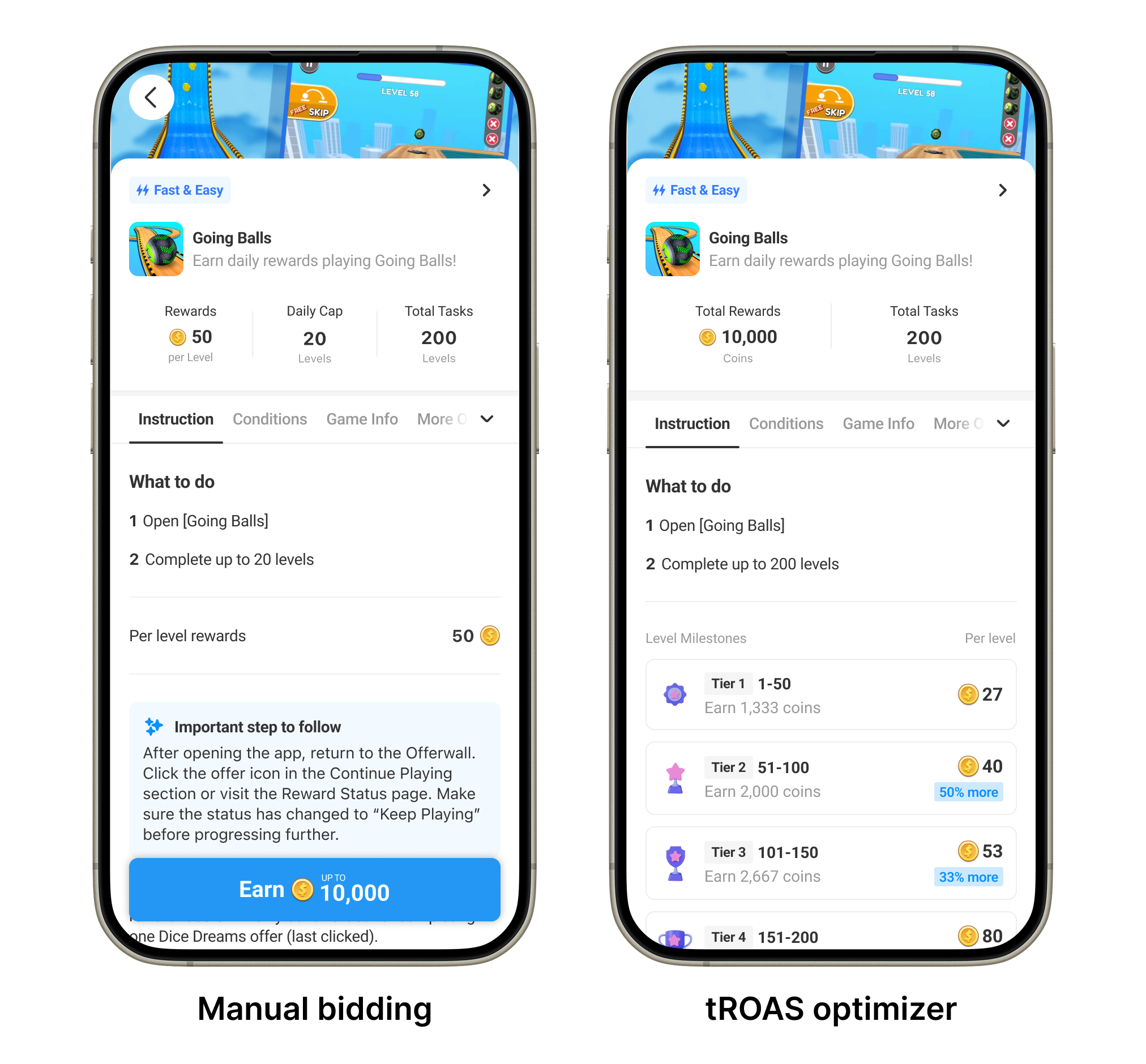Introduction to ROAS optimization
The tROAS optimizer is an automated bidding system that you can have enabled in daily rewards offers. It uses user engagement data and your ROAS goals to dynamically generate offer event bids. A ROAS goal is the amount of revenue you aim to earn from each newly acquired user.
When the Tapjoy Offerwall loads for a user in a publisher app, the tROAS optimizer predicts the expected revenue this user is likely to generate. Expected revenue includes in-app purchase (IAP) revenue, in-app ad (IAA) revenue, or a combination of both (hybrid). Based on its analysis, the tROAS optimizer generates a bid amount tailored to the user’s predicted value.
By automating the bidding process, the tROAS optimizer can help you to maximize your CPE offer revenue by automatically bidding at a granular level. This automatic granular bidding ensures that your budget is spent efficiently to acquire high-quality users—those most likely to generate significant revenue—and avoid overspending on lower-quality users.
The feature also saves you time and effort by removing the need for manual bid management and frequent offer configuration adjustments.
Learning stage
The tROAS optimizer enters a learning stage to assess whether the predicted revenue and generated bids help to achieve your target ROAS. The learning period lasts for the duration of the CTCT window plus an additional seven days. During this period, the optimizer collects a full week of complete spend data. For example, if the CTCT window is 30 days, the learning stage will take 37 days (30 days + 7 days) to gather one complete week of spend data.
Supported settings
The tROAS optimizer is currently available for use only in CPE offers that have specific settings. These settings are described in the following sections.
Reward types
The tROAS optimizer supports offers that use the daily rewards reward type. A daily reward is given to users for completing repeatable events, such as finishing a level. Users can complete the same event and get rewarded for it multiple times a day each day, until the event’s lifetime conversion cap or maximum conversion window is reached.
Target ROAS measurement periods
The tROAS optimizer supports D3 and D7 target ROAS values.
The D3 and D7 values represent the expected ROAS within three and seven days (respectively) after the user installs the app.
Note: D3 target ROAS is limited to offers that monetize based only on IAA data.
Revenue sources
The tROAS optimizer supports all app revenue sources for ROAS calculation: IAP, IAA, or a hybrid of both.
Daily rewards offers
For daily rewards offers, the tROAS optimizer divides the predicted revenue into four tiers, and then generates and distributes bid amounts across these four tiers.
The tROAS optimizer differs from the manual bid structure, which pays the same bid regardless of the event’s difficulty.
The following image compares a daily rewards offer using manual bidding versus the tROAS optimizer. With manual bidding, a single fixed bid is applied to all events. With the tROAS optimizer, an increasing bid amount is distributed across the four tiers (Tier 1, 2, 3, and 4).

This tiered approach motivates users to progress further within your app, which can help increase user engagement and retention.
Eligibility criteria and requirements
To use the tROAS optimizer, your offer must meet specific eligibility criteria and technical requirements. The eligibility criteria determine if your offer can use the tROAS optimizer; the requirements specify the required technical setup your offer must have once it’s confirmed eligible.
Eligibility criteria
Your offer must meet a minimum data threshold to be eligible for the tROAS optimizer. It needs enough historical data to help you reach your target ROAS efficiently and effectively. To review your offer’s data eligibility, contact your account manager.
Requirements
The Mobile Measurement Partner (MMP) you’re using must be Adjust, AppsFlyer, or Singular.
If you’re using AppsFlyer and want to pass ad revenue data to the tROAS optimizer, ensure that you pass this data through postbacks. For more information about passing ad revenue data through postbacks, refer to Integration with Appsflyer. If you have questions about how to do so, contact your account manager.
 ENG
ENG